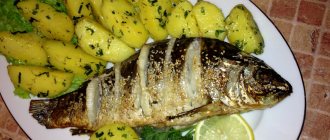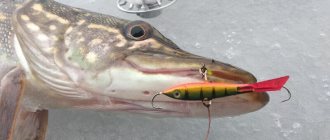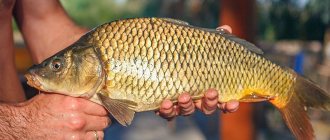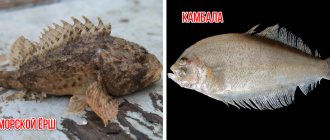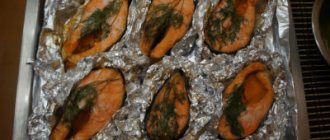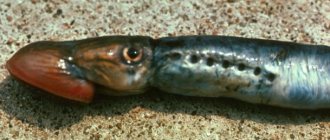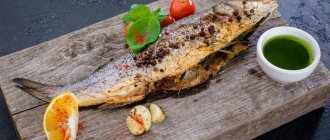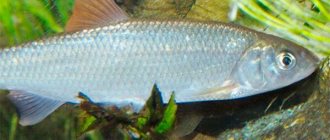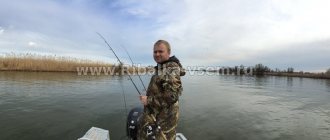03/16/2019 Pierre Gagnaire Cooking Carp is one of the most popular types of fish in modern cooking. Many dishes are prepared from it, which, by the way, turn out to be quite tasty.
As practice shows, many housewives very often think about whether the carp is bony or not, and also talk about how to cut it. Let's talk about all this further in more detail, and also consider several recipes for preparing dishes from this type of fish.
About the benefits of carp
Before you begin to understand in detail how to cook carp, you should list some beneficial properties of this type of fish.
Carp is a freshwater fish that is quite often found in the catches of many Russian fishermen. It contains a huge amount of useful microelements and vitamins, which is why this type of fish is often recommended for people suffering from cardiovascular diseases, liver problems or anemia. It has also been proven that regular consumption of carp fillet helps strengthen the human immune system, as well as significantly improve his well-being.
Carp is often valued for its low calorie content: 100 g of the product contains only 97 kcal. Moreover, the product is absorbed quite quickly, which is why it is often recommended for use by children and the elderly.
Where to look for carp? Habitats of carp. Choosing a fishing spot
Carp is a sedentary fish, not inclined to arbitrarily change its permanent habitat. Therefore, when fishing for carp, the choice of fishing location is so important; the success of catching carp depends on it.
Many novice fishermen, when choosing a future place for catching carp, make the same mistake: they strive to find a “more beautiful”, “more comfortable” place on the river. For example, it seems to them that they need to choose a place next to a sandy beach, and that on the other side of the river there is a beautiful landscape that is pleasant to look at.
In a “comfortable” place it is convenient to approach the water, it is convenient to place fishing rods on the gently sloping bank, it is convenient to cast, since there are no trees hanging from above. In a word, everyone enjoys such a place, but for some reason the fish don’t bite on it, and if they do, it’s some small thing, and not the desired carp at all. The hopes of novice fishermen to lure carp to such a place with abundant bait are in vain. Carp doesn’t want to take it - even if you crack it!
What is the reason for the failure? The reason is that the cautious carp avoids “comfortable” places frequently visited by fishermen. And in general, it’s not so easy to lure him out of his habitat into clean water; you need to study the river and know the “fish paths.”
If you are on the river for the first time or you simply do not have time to study the river for a long time, it would not hurt to conduct a survey of the local population. One should not neglect the opportunity to listen to the advice of more experienced fishermen in searching for carp habitats. One should not think that fishermen deliberately hide such places from the “uninitiated.” On the contrary, having sensed your sincere interest, they will most likely share their experience and talk about where and when they managed to catch carp.
Where should you look for carp?
Wild carp loves wild and secluded places, prefers holes and depths, and even with snags. In rivers, carp favor quiet places where the current slows down, where there are washouts near steep cliffs, holes at river bends, near rubble of stones, driftwood and snags. You can meet carp not far from such pits, on edges bordering settlements of zebra mussels, in river bays at the edge of water thickets. The carp comes to such “fish table” at night and at dawn.
In the summer heat, carp can be found at the edge of reeds and in thickets of aquatic plants (water lilies, arrowheads, pondweed, water buckwheat), but in such a place the depth should be at least 2-3 meters. Only at dusk and when dawn breaks, carp can be found in shallow water.
When searching for carp places on the river, you need to examine the nature of the bottom - the bottom topography. What are we looking for? First of all, differences in the bottom: edges, holes, hills - tables, obstacles lying on the bottom in the form of driftwood and sunken trunks. The bottom in such places should be silty, clayey, that is, not hard sand. The only places with a hard bottom where carp can be found are colonies of zebra mussels; carp feed here, but are found here mainly at night.
Windbreaks and fallen trunks are very important - it is advisable that they be close to the place of fishing (this is the “carp house” from which the carp comes out in search of food.) The path from the snag to the ridge with pearl barley is carp paths, it is along the edges that the fish moves in search of food. If you find a hole nearby, mark the boundaries of the hole. In the pit itself, the carp practically does not take, but only at the entrance or exit from the pit.
The clayey banks at the bend of the river, where the bottom goes into the depths with sharp ledges, are very good. You need to pay attention to whether there are reverse currents in the chosen place, where the water swirls into whirlpools, whether there are holes at the bottom, edges, transverse braids and furrows, driftwood and snags where bait can linger.
Let's reveal another secret: the surest way to discover the carp's feeding place is the carp's splashes in the morning, at dawn. In such a place the carp “plays” - it jumps up with a wide splash. It is clear that you can find such a place if you arrive at the river long before dawn. Remember the description of carp fishing in Sholokhov’s book “Quiet Don”? There carp almost jumped into the boat, playing at dawn, in the same place they caught well. If you find a place where carp plays at dawn, half the success is guaranteed!
There are also cases described when success in catching carp came to those who stopped in a deep forest, where the branches of large trees hung from above, and the bank went into the water with a cliff. There may be reeds in the water, which also prevent easy casting, but they mask the angler from the fish.
It is possible to attach a carp to a more convenient place only if in this place you can guess the depth, changes in the bottom and there is no strong current that will carry away the bait. But it may also turn out that when the carp approaches our convenient place, it’s time for us to leave!
So when looking for good places to catch carp, it is better to follow the rule - look for the place that is convenient for the fish, and not for the angler! You need to understand that during a one- or two-day fishing trip it is easier to catch carp where it lives and feeds.

Carp and carp: what's the difference?
During the season, on the fish counters you can find a real abundance of different types of sea and river products. It is worth noting that the most popular among them are carp and carp. Moreover, practice shows that many housewives can easily confuse carp with carp. What is the difference between these types of fish?
First of all, the difference between them is made by scales: carp does not have them, but carp is completely covered with medium-sized scales. In addition, when choosing a fish, you should pay attention to the structure of the carcass: in carp it will be much wider than in carp.
When choosing between carp and carp, chefs strongly recommend giving preference to the first option. This is due, first of all, to the habitat of the individuals: unlike carp, they choose cleaner water bodies. Undoubtedly, this affects the taste of the prepared dishes.
Carps as an invasive species in Australia
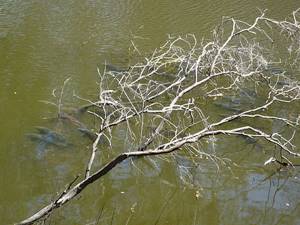
Carp were introduced to Australia in 1859 and have proliferated enormously and now make up more than 80 per cent of the total fish biomass in the Murray hydrosystem. Plans are being discussed to combat it using carp herpesvirus type 3 (CyHV-3, also known as koi herpesvirus - KHV), which could wipe out up to 95% of the carp population in the Murray, but could provoke another environmental disaster[7] associated with rotting mass dead fish.
How to choose a good fish
To prepare a delicious dish from carp, you need to use only high-quality fish caught in a clean reservoir.
There is a certain list of recommendations that should be followed when choosing a carp carcass. Thus, it is worth noting that fresh fish will always have clean and transparent eyes, as well as shiny scales without the presence of dark spots on the surface.
When choosing a carp, you should definitely smell its gills - they should not have an unpleasant odor, and also have a clean appearance.
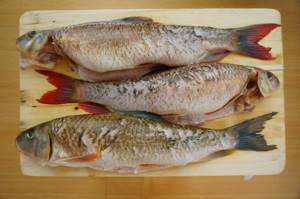
What does carp fish look like?
The carp fish looks discreet. Those who have ever caught or at least cooked mirror carp will certainly notice the similarities between these representatives of the same family. You can distinguish mirror and common carp from each other by the color, shape and color of the fins and the presence of a black border in the latter and along the edge of each scale.
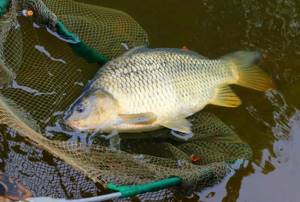
The description of the carp fish can be summed up in two words - common carp. But for those who are not intimately familiar with carps and need details, we will write down the details. Thus, carp are quite large, their body has an elongated shape and is covered with large scales lying in a smooth layer. Its sides are gray, often with a visible golden tint; from the belly to the back the shade darkens, even to black.
Carp weight
Usually their weight does not exceed 20 kg, and their length is up to a meter, but cases of catching larger representatives of the species are increasingly being recorded. It is interesting that not so long ago carp were included in the top hundred major pests for humans, as a species with a high invasive danger. The fact is that omnivorous predators, as the population grows, begin to actively destroy everyone who lives with them in the same body of water. And due to their digestive characteristics, carps eat almost constantly, including river crustaceans, fish, plankton, plants, and the eggs of their relatives.

The meat of common carp is incredibly tasty, juicy, and soft. There are practically no hard small bones in the skeleton, which is why chefs around the world love it so much. Among the cooking recipes there are boiled, steamed, fried, stewed, baked dishes of varying calorie content. It would not be amiss to note that with a rather modest calorie content, fish is rich in vitamins, microelements and fatty acids, which are almost not destroyed during heat treatment. But it is important that the catch site is not environmentally polluted, since the omnivorous carp can be poisonous.
How to cook carp
Cooks really like to prepare dishes from carp, since the process of creating them is always simple. Practice shows that even an inexperienced housewife can create an excellent dish from this type of fish.
The fillet of the carp carcass has a pleasant sweetish taste and is also characterized by an increased level of juiciness. Culinary experts recommend preparing it in different ways: baking, heat, boiling, stewing, salting, and even drying. In fact, carp makes very tasty and rich soups, as well as juicy cutlets.
Habitat
Carp have one amazing feature - they can be either semi-anadromous or sedentary, that is, they can swim all their lives in the same body of water without making any migrations. These aquatic inhabitants are considered freshwater. But there is also a sea fish called carp. She lives in the seas.
The predatory fish carp prefers to live in calm rivers with a slow flow. It can swim in still water. It is desirable that the bottom be muddy, there are snags and flooded trees, holes. The main thing is that the reservoir is rich in bottom food. In nature, this fish can be seen almost throughout the entire territory of Eurasia.
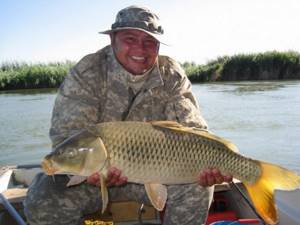
How to clean carp
When looking at a carcass of fresh fish, one question immediately arises: how to cut a carp? It is worth noting that this procedure is extremely simple and does not require much effort. It is important to consider that it is best to work with fish with rubber gloves, close to the sink.
How to clean carp? First of all, it is necessary to cut off the fins from the carcass. Next, you need to press the fish with your left hand in the area of the head, and then use a scraper to remove the scales from it, directing the movement of the tool diagonally, in the direction from the tail to the head. This process should be carried out dynamically.
After all the scales have been removed, you should rip open the fish’s belly and pull out the intestines, removing the black film along with them. During the gutting process, it is important not to touch the gall bladder, otherwise the taste of the product will be spoiled. If the bubble does burst, you need to generously rub the inside of the carcass with salt and, after holding for several minutes, rinse it under running water.
as a last resort, you need to cut off the head of the fish or, as a last resort, remove the gills and eyes from it (if suddenly the cooking will be carried out directly with the head).
When to catch it?
Catching carp has a number of its own characteristics, and especially depends on the period and temperature conditions. Many fishermen begin successful fishing for carp in early spring.
Read here Danube salmon - where, how and when to catch? Review of baits and gear necessary for salmon fishing (125 photos and videos)
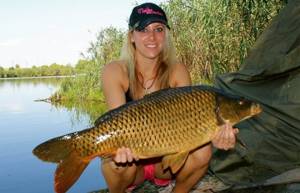
The closer to the end of spring, the warmer the water in the reservoirs and the more intense the carp are biting. Subsequently, the bite drops to zero, as the fish begin the spawning period, which occurs at the end of spring and the beginning of the summer season.
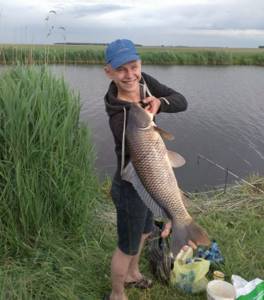
In the middle of summer, the bite of carp also most often does not please fishermen, since this fish is quite susceptible to heat. For summer fishing for carp to be successful, it is accompanied by a long period of bait.
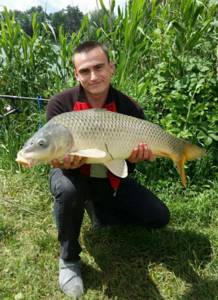
In the autumn, when the summer heat subsides, the carp begins to be active again. Before the onset of cold weather, the fish tends to gain a little weight, and the bite in late autumn is quite good.
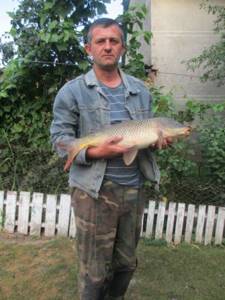
As for the time of day, carp bite best in the early morning, so the fisherman should not expect to get enough sleep if he is going to get a good catch.

As practice shows, on average, carp bite after five o’clock in the evening and until about 11 o’clock in the morning.
Carcass cutting
Bony carp or not? It is worth noting that this type of fish is distinguished by an impressive level of bonyness, which is why cutting it can be done with some difficulties. In some cases, it is even necessary to crush small bones.
To cut a carp carcass, you should use a large and well-sharpened fillet knife. First you need to make an incision from the gills to the spine. Further up, towards the head, it is necessary to resolve the upper part of the carcass, located above its spine. Now, having cut off the tail, you need to lift the sirloin of the carcass and carefully separate it from the ribs. The same must be done with your other half.
The prepared halves of the carcass must be placed on the board, skin side down, and then carefully remove the skin from them.
Cooks strongly do not recommend leaving “waste” after cutting carp - they make excellent and very rich soups.
Spreading
The natural range of the species consists of two parts:
- reservoirs of the Ponto-Caspian-Aral region;
- the basin of the Far Eastern rivers and rivers of Southeast Asia, from the Amur in the north to Yunnan (China) and Burma in the south[1].
Acclimatized in many reservoirs of Central Asia, Western and Central Siberia and Kamchatka.
Forms: residential and semi-passage. The first one constantly lives in one body of water, the second one - in desalinated areas of the sea or lakes, with migration to spawning rivers.
How to cook classic carp cutlets
Questions about whether carp is bony or not should not worry those who plan to make cutlets from this type of fish. Practice shows that they turn out very tasty and juicy. Preparing this dish is very simple; even an unprepared housewife can cope with the task.
To prepare the most tender cutlets, you need to take 500-600 g of pre-prepared carp fillet and pass it through a meat grinder. After this, several pieces of loaf, previously soaked in milk (150 ml), as well as a separately fried onion, should be added to the fish mass. All combined ingredients should be mixed until smooth.
At the final stage, add a little salt and ground pepper to the finished minced meat, as well as finely chopped dill (to taste) and a chicken egg. After thoroughly mixing the mass, you need to form cutlets of the same size from it and roll each of them in breadcrumbs, fry in vegetable or butter on both sides until a golden crust forms.
Ready-made cutlets go perfectly with mashed potatoes and side dishes of rice, as well as boiled pasta.
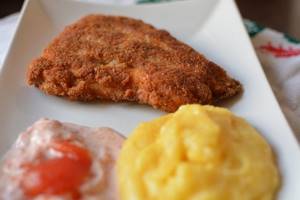
What do you need to catch carp? Used gear and equipment. Features of carp fishing
Real carp fishing is not at all comfortable carp fishing, which most anglers imagine as sitting in comfortable chairs waiting for a bite.
Catching carp is active fishing, it involves actively searching for carp and moving along the shore in search of “carp trails.” That is why, before starting fishing, you need to feed not one, but preferably two or three places; if there is no result in one, you need to move to another.
Do not forget that carp is a very sensitive and careful fish. If the angler behaves imprudently, makes noise and makes unnecessary movements, the carp may not approach the bait. It also happens that at the height of the bite, careless fishing for one carp can scare away the entire flock, and you will not see any more bites in this place.
The stomping of feet on the shore, sharp blows, loud voices at the fishing site are completely unacceptable; carp fishing requires absolute silence. That is why, if you plan to fish from a boat, then you need to choose an inflatable boat, at least a wooden one, but not a metal one. The carp will not tolerate the creaking of rowlocks or the sound of the anchor on the side of the boat and will leave the fishing spot. Experienced carpenters use a pole instead of an anchor.
They start fishing in an important place long before sunrise, the earlier the better. Ideally, you need to arrive at the fishing spot in the dark, make a starting feed and prepare your gear in order to make casts at the first rays of the sun. The carp approaches closer to the shore under the cover of night darkness. If the carp begins to play and jump up in the place you fed, this is a sign that the fishing can be successful. Subject to your skill, you will be with a catch.
When fishing for carp, different tackles are used, the main ones are a float rod with a “running” rig and bottom tackle (feeder with a feeder or carp rig with boilies).
A float rod is used when fishing from a boat in lakes, as well as from the shore in rivers, in places where the depth is close to the shore and the current is weak or there are “returns”. Carp is a powerful fish, so the tackle must match it! The rod itself should be tough (fast), it should allow forced fishing. The rod is either a spinning rod with a high test weight of 80-100 g, fast action and a length of 2.7–3 m, or a special powerful carp rod 5-6 meters long.
Shorter rods are convenient for fishing from a boat, and for fishing from the shore, naturally, longer rods are preferable. The rod is equipped with a powerful carp reel with a baitrunner. The rod is installed on special powerful carp stands at an angle to the horizon, this is done so that the current does not put strong pressure on the fishing line.
Choice of fishing line. All experienced bait fishermen unanimously advise using only monofilament because of its stretchability, which somehow compensates for the powerful jerks of hooked fish. Braided fishing line does not have this ability. In addition, the “braid” collects more mud and plants and is more often cut on snags and steep edges overgrown with shells. But regarding the diameter of the fishing line used, the advice is very different. It is clear that the larger the diameter, the greater the chance of coping with large fish.
Hunters of trophy carp take a fishing line of 0.4 mm, sometimes even 0.6 mm. But, perhaps, this is already an extreme, because a fishing line that is too thick alarms the extremely distrustful carp, not to mention the fact that thick fishing lines are more easily blown out by the current. Apparently, the optimal diameter of the fishing line is 0.25-0.3 mm, because a fishing line with a diameter of 0.3 mm is enough to catch carp up to 10 kg, but a beginner is unlikely to catch large fish!
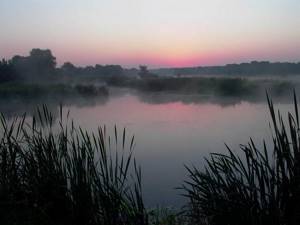
The leash, accordingly, can be 0.23-0.25 mm, the hooks are special carp hooks with a short shank and a sting that looks slightly to the side. Such a hook penetrates the lip of a fish from any position.
The float for the fishing rod, of course, should be sliding, adapted for fishing from depth, the sinker should also be sliding, it does not offer resistance to the fish that takes the bait. The carrying capacity of the float is not critical, because the depth is set greater than the depth at the fishing site; for the most part the float will lie on the water. But the color of the float is of decisive importance; the float should be disguised as a twig or reed, that is, have a dim brownish-greenish color.
The leash is made very long (0.3-1 m); it, together with several feeding pellets, must certainly lie on the bottom. Carp will not take the bait if he notices that the fishing line is stretching upward from it! Of course, a long leash coupled with a lying float makes the bite less noticeable, but the carp takes the current decisively and sharply, because it does not have time to think and bite - the food can be carried away by the current.
Bottom tackle is used when fishing for carp much more often than float tackle. This is understandable: we usually fish from afar and always from the bottom. As a bottom tackle, you can take a feeder with a feeder, but most often - a special carp tackle with a sinker. The equipment of carp tackle is usual: a leash, a swivel, an anti-twist to which a sinker is attached. A leash with a carp rig (carp hook with a hair attachment for boilies) is tied to the end of the fishing line.
In strong currents, heavy weight sinkers (up to 100 grams) and a special flat shape with spikes are used, as if sticking to the ground. The non-slip sinker is designed for self-hooking - the fish hooks itself when it tries to swim away, grabbing the nozzle. Sometimes the sinker is attached in such a way that it can come unfastened spontaneously if, for example, a carp gets the tackle into snags. Thus, the sinker does not interfere with landing large fish.
After casting, the slack in the fishing line is eliminated and the rod is secured to a special stand at an angle of 45-60 degrees to the horizon. This arrangement of the rod allows you to raise the fishing line above the bottom and reduce the likelihood of it getting snagged or cut, and reduce the pressure of the water flow on the fishing line. They hang a weighted swinger and install an electronic sound bite alarm. It is very important that the rod in the rack is securely fastened, because the carp, when pulled, can pull the rod into the water.
You don’t have to rush to hook the carp on the bottom tackle; for the most part, the carp hooks itself. But the fighting must be forced and forceful. There are always a lot of different shelters on the river, and the carp first of all strives to rush into snags, where it can thoroughly tangle the tackle. Then you are in danger of losing both the trophy and the equipment.
If, after all, the carp gets the tackle into the snags, then usually the rod is put back on the stand and, tapping the rod, they wait for the fish to come out of the strong place. Another danger is the edges with shells, so that the line is not cut when fishing on the sharp edges of the shells; they try to hold the rod higher and do not allow the carp to walk along the edge for a long time.
The caught carp resists strongly and desperately, fighting literally to the last. You should not expect that his resistance will weaken when you manage to drag him to the surface and give him a breath of air. There is no need to lose self-control even when the carp has already been brought to the landing net. Make one awkward move and the carp will jerk to the side with unexpected force. Often this last jerk helps him out - he either breaks the tackle or his lip.
Needless to say, catching carp with sports gear presupposes respect for your opponent and the obligatory return of the fish to its native element after its capture. Weigh the caught trophy, take a photo with it - and release it back into the water! The humane principle of “catch and release!” recognized by all serious carp anglers and carp fishermen. It is worth recognizing that carp is not a fish for the frying pan. This is a highly athletic fish, the fight against which is the main reward of a true fisherman!
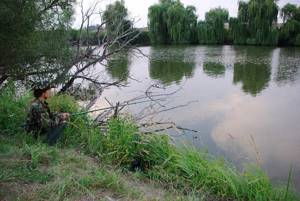
Fish baked in the oven with potatoes
To cook carp in the oven with potatoes, you need to use only large fish carcasses, weighing about 1.5-2 kg.
The fish should be prepared for further baking by cutting it according to the technology described above, without disassembling it into fillets. if desired, you can even leave the head, after removing the gills from it and gouging out the eyes.
Next, place onions cut into large rings (1-2 heads) on the bottom of the baking dish chosen for baking. On top of it you need to lay out potatoes, cut into slices 1-1.5 cm thick, as well as prepared fish, greased on both sides with a small amount of vegetable oil - this is the only way to form a very appetizing golden brown crust on its surface at the end of the baking process. Now the baking sheet with the fish must be placed in the oven for 50 minutes (bake at 200 degrees). After the first 30 minutes, the fish must be taken out to sprinkle with a small amount of fresh lemon juice, and then sent back.
When the carp is ready, you need to remove it from the oven and let it cool a little. It should be served along with baked vegetables and, if desired, fresh herbs.
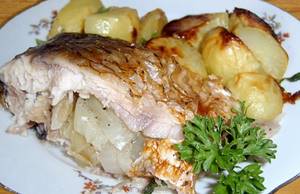
What does it eat?
Competent fishermen know: before going fishing, you need to find out what the prey eats. This knowledge helps to select the right baits and complementary foods to which the species will respond better than other inhabitants of the reservoir. There are fish that are very picky about food, and there is carp - an omnivorous semi-predator, willingly rushing at almost any thrown treat.
The main increase in the mass of common carp occurs in the first 5-7 years of life. Therefore, young animals spend almost the entire warm season in places with an extensive food supply. Depending on their age, individuals choose what to eat:
- Immediately after hatching, the fry eat microscopic insect larvae and fine-grained plankton, consisting of eggs and tiny crustaceans.
- Teenagers sink to the bottom, where they catch larger food: crustaceans, small bottom fish.
- Young fish older than six months do not hesitate to feast on other people’s eggs and their own, shed during the spawning period. Usually the “caviar” time coincides with the beginning of spring, when practically no other types of food can be found.
- At the peak of the warm season, carp eat young shoots from aquatic and coastal plants: reeds, egg capsules, cattails. Then they allow themselves to eat leeches, snails, worms, and zebra mussels.
The body of the common carp has a very specific structure - it does not have a stomach. In order not to die from exhaustion and constantly maintain weight, he needs to continuously eat. That’s why experienced fishermen know: if a carp doesn’t bite, it means it simply doesn’t live here.
Carp, baked whole
This recipe for baked carp in the oven is quite simple, because the process of preparing fish according to it is feasible for any housewife.
To prepare fish in this way, it is best to use a large carcass. It must be cleaned of scales and entrails, and then thoroughly washed and rubbed with a mixture made from ground pepper and salt, taken to taste. To eliminate the river smell, lightly sprinkle the carcass with lemon juice, after making several cuts on the skin.
How to bake carp? After all the preparations, you need to place the fish on a baking sheet with foil, greased with a small amount of oil and send it to the oven, preheated to the maximum temperature. After 25-30 minutes, the fish carcass will begin to crust, you need to remove it and, smear it with a layer of mayonnaise, cover it with foil, and then put it back in the oven to finish the cooking process. In 20-25 minutes the dish will be ready.
Carp baked in sour cream
How to cook a whole carp in the oven? To do this, you can use a recipe that calls for marinating it in sour cream sauce.
To create this spicy and incredibly tasty dish, you should take a large carcass weighing about 2-2.5 kg and cut it using standard technology, removing the scales and entrails. After this, you need to make transverse cuts about 1-1.5 cm thick on the back of the carcass, and then rub it generously with a mixture of pepper and salt, and also sprinkle with lemon juice, which will help eliminate the unpleasant river smell of the product.
Place the carcass on a prepared baking sheet lined with oiled foil. You should stick a few sprigs of parsley inside the fish, then evenly coat it with a glass of sour cream and put it in the oven, preheated to 180 degrees. After 40-50 minutes, the baked carp with a fragrant crust will be ready - it must be removed from the oven and, transferred to a serving dish, sent to the table.
Carp size
Carp grows quickly - at the age of 1 year it can reach a length of 12 cm and a weight of 30-40 grams. Intensive growth lasts up to 7 years, then the process slows down and stops after 8 years. An adult is on average 40-50 cm long and weighs 4-5 kg. The largest carp reach sizes of more than 100 cm with a body weight of 30-35 kg. It has been practically proven that the maturation of fry of carp in reservoirs is faster than in rivers, and males mature more slowly than females. The lifespan of carp ranges from 30 to 37 years.
Carp stuffed with mushrooms
How to deliciously cook carp in the oven? Another amazing recipe for creating an incredibly tasty dish involves baking it stuffed.
To create an appetizing and very tasty dish, you need to clean the carcass from scales, fins and gut it. After this, rub it with salt mixed with pepper and put it in the refrigerator for half an hour.
While the carcass is marinating, you need to prepare the filling for it. To do this, fry a couple of finely chopped onions in a generous amount of butter. As soon as the vegetable acquires a golden color, you need to add 200 g of chopped mushrooms to the frying pan and, bringing the mass to half-cookedness, combine it with half a glass of boiled rice, as well as a couple of hard-boiled eggs.
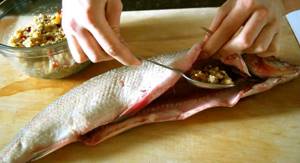
The marinated fish must be placed on a baking sheet covered with foil and thoroughly stuffed with the prepared mixture of mushrooms, onions, rice and eggs. Now the fish should be evenly coated with sour cream (100-150 g) and baked in an oven heated to 180 degrees. In an hour, the savory dish will be ready.
Fried carp
Knowing how to cook a whole carp in the oven, you can experiment with this type of fish by frying it in a frying pan.
To prepare carp using this method, you need to take a large carcass weighing about 1.5 kg and cut it as recommended above, without disassembling into fillets. After this, the gutted carcass should be cut into portions about 2 cm thick.
Next, each piece should be sprinkled with a mixture made from pepper and salt, then rolled in a generous amount of flour.
Prepared pieces of fish should be fried in a frying pan with hot vegetable oil (about 5 tbsp). How to fry carp in a frying pan so that the fillet remains soft and juicy? To do this, it is necessary to carry out the heat treatment process on both sides evenly, for 7 minutes on each.
Place the finished pieces of fried carp on a serving dish, sprinkle with finely chopped parsley and dill, and, if desired, sprinkle with a small amount of fresh lemon juice.
Having figured out how to present carp in a frying pan, it’s worth saying a few words about its presentation. So, this type of fish goes perfectly with vegetables and mashed potatoes. As for drinks, white wine is ideal.
Some housewives ask this question: how to fry carp in a frying pan so that the taste of the product is only enhanced? Experienced chefs strongly recommend using butter rather than vegetable oil for this, which gives the finished fish a more delicate taste.
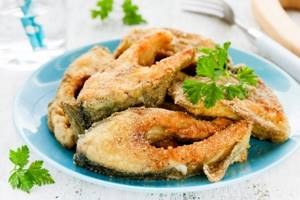
Description
A large omnivorous fish with a thick, moderately elongated body, covered with large, smooth, tightly fitting scales. The sides are golden in color, the back is darkish. The color may vary depending on the habitat. At the base of each scale there is a dark spot; the edge of the scales is bordered by a black dotted stripe. Scales in the lateral line are 32-41.
There are, although rare, specimens weighing over 20 kg and more than a meter long.
The head is big. The mouth is semi-lower, retractable. The lips are well developed. The upper lip has two pairs of well-developed short whiskers.
The dorsal fin is long with a small notch, the anal fin is short. The dorsal and anal fins each have a jagged, spiny ray (“file”).
Within the domesticated form of the European carp there are mirror or king carp ( Cyprinus rex cyprinorum
) with very few rows of extremely large scales and the rest of the body bare, and leathery carp (
Cyprinus nudus
) with completely bare skin.
The domesticated form of the Amur carp is the brightly colored ornamental koi carp.
Carp on the grill
Don’t know how to cook delicious carp? Try pouring heat over it on the grill - the result will certainly exceed all expectations!
How to cook carp on the grill? To prepare a tasty dish, you need to take a fish carcass and cut it up, removing the scales, entrails and head with fins. After this, you need to wash the fish and dry it with a paper towel.
Separately, you should prepare a delicious sauce for carp. To do this, mix in one bowl the juice squeezed from the onion, 50 ml of soy sauce, a little ground pepper, chopped parsley and dill, as well as juice squeezed from the lemon. Pour the created marinade over the fish and leave it to marinate for 15 minutes, placing it in the refrigerator.
At the end of the allotted 15 minutes, you need to take out the fish, put a pre-cut onion into rings inside it, and then, having coated it on all sides with oil, place it on the grill.
It is worth noting that fish prepared according to this recipe will win the hearts of all gourmets invited to the table, because it turns out very juicy, aromatic and incredibly tasty.
Heh
It is worth paying attention to the fact that carp heh is a very tasty and dietary dish. To prepare it, you need to take a large fish (about 2 kg), clean it, gut it and, after separating the fillets, cut it into portions.
The prepared pieces should be poured with vinegar essence (4 spoons) and, after stirring, sent to the refrigerator for a couple of hours for marinating. Don't worry about using large quantities of vinegar - at the end of the entire cooking process, only a slight sourness will remain.
While the fillet is marinating, you need to prepare the remaining ingredients. To do this, cut 4 onions into half rings, grind 3 g of coriander seeds in a coffee grinder, and also coarsely chop a bunch of greens (cilantro, dill, parsley).
After a couple of hours, add greens, onions and chopped coriander to the marinated fish, as well as a little salt, 2 tablespoons of sunflower oil and 3 tablespoons of soy sauce. After adding a little ground red pepper, mix all the ingredients thoroughly until smooth, and then add a pinch of sugar and a crushed clove of garlic to them - this will give the finished dish a special piquancy.
Heh from the carp is ready. If you want to get a delicacy with a more pronounced taste, you can let the mixture brew in the refrigerator for about two hours.
Ear
It is known that carp produces very tasty, tender and rich fish soup. To prepare this soup, you need to take a couple of small fish, cut them up, cut them into small pieces, and put them in a saucepan. It is worth noting that heads (without eyes and gills), as well as fins and tail can also be used to prepare fish soup.
After putting the fish soup on medium heat, you need to start preparing the vegetables. To do this, you need to peel the onion and carrots. The components need to be coarsely chopped and placed in a common pan. After 20-30 minutes, remove the cooked fish pieces from the broth and strain the liquid. Next, add a couple of diced potato tubers to the strained broth and continue the cooking process.
Meanwhile, in a hot frying pan with a small amount of vegetable oil, fry a spoonful of tomato paste diluted with a small amount of broth.
Separately, you need to cut the fish into portions. Bony carp or not? Yes, the carcass of this fish contains a large number of both large and small bones, which should be removed whenever possible during the filleting process.
When the potatoes are cooked, add pieces of fish and fried tomatoes to the soup. Before serving, the dish can be decorated with finely chopped herbs, adding it to each plate separately.
If desired, you can prepare a very rich fish soup from the head of the carp and its backbone. The principle of creating the dish is the same as in the described recipe. It is also important to understand that the fish soup from the head of a carp turns out incredibly tasty and rich only if a fresh product is used for its preparation. Moreover, it must be without gills and eyes.
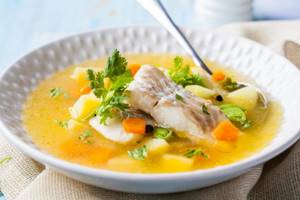
Is carp bony?
Carp differs from other representatives of the Cyprinidae order in that it has very tender and nutritious meat, and is also relatively non-bony , which allows it to be included even in children’s diets. Almost all fish bones are large and easily removed, but occasionally you can find small ones in small quantities.
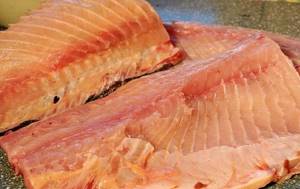
It is also worth noting that the larger the specimen you choose, the less bone tissue you find, and all of it is quite large. Experienced cooks claim that if we compare carp and other freshwater fish in terms of bonyness (for example, silver carp), the first one definitely wins.
How to pickle carp caviar at home
Few people realize that carp caviar can be salted rather than thrown away. It is fashionable to do this both dry and by marinating the product in brine.
How to salt carp caviar at home using the dry method? To do this, you need to take the main product and lower it into boiling water for a few seconds. As soon as the skin begins to peel off easily, remove it.
The separated eggs must be placed on the bottom of a flat dish, strewn with coarse salt, and the same amount of salt must be sprinkled on top. After covering with a lid, the container with caviar should be placed in the refrigerator for 3-4 days - this is how long the appetizer will be ready. Now the caviar must be removed from the resulting brine and rinsed twice with warm water.
It is important to understand that the taste of the finished snack will directly depend on how accurately the amount of salt was determined. In total, to prepare the salt snack, you need to take a total of 12-15% of the weight of the total weight of the caviar.
Carp nutrition
What does carp eat? The larvae attached to the plant feed on reserves from their natural yolk sac. After a few days, they end, and the embryos move to plankton - invertebrate small crustaceans, ciliates, rotifers and other microorganisms. The carp does not have a stomach, and the intestines are longer than the body, so the carp’s nutrition consists in the fact that it is able to eat without interruption. When the fry grows up, it becomes omnivorous.
Both protein and plant foods are used as food: larvae, mollusks, worms, insects, fish and frog eggs, any algae or plants. If there is not enough food, small fish are added to the diet. The greatest amount of nutrients is consumed two to three weeks before spawning and then immediately after spawning. During breeding, feeding does not stop, its intensity simply decreases. Large representatives live separately so that they have enough food nearby. The carp's appetite disappears only when the water gets colder.
